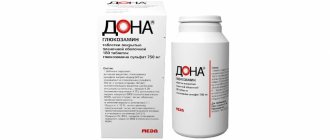Buy Maxicold Rhino powder for preparing a solution for oral administration Raspberry 15g No. 10 in pharmacies
Instructions for use Maxicold Buy at the pharmacy Maxicold Rino por. d/r-ra internal Raspberry 15g No. 10 Dosage forms powder for injection. oral solution raspberry 15g
Synonyms GrippoFlu for colds and flu GrippoFlu Extra for colds and flu Stopgripan Stopgripan forte TeraFlu for flu and colds Group Combinations of paracetamol and adrenergic stimulants International nonproprietary name Paracetamol + Phenylephrine + Pheniramine + Ascorbic acid Composition Active substances: paracetamol 325 mg, pheniramine maleate 20 mg, phenylephrine hydrochloride 10 mg, ascorbic acid 50 mg. Manufacturers Pharmstandard-Leksredstva OJSC (Russia) Pharmacological action A combined drug that has antipyretic, vasoconstrictor, analgesic and antiallergic effects. Paracetamol has an antipyretic and analgesic effect: it reduces the pain syndrome observed with “colds” - sore throat, headache, muscle and joint pain, and reduces high fever. Pheniramine has an antiallergic effect: eliminates swelling and hyperemia of the mucous membranes of the nasal cavity, nasopharynx and paranasal sinuses, reduces runny nose and lacrimation. Phenylephrine has a vasoconstrictor effect: it reduces swelling of the nasopharyngeal mucosa. Ascorbic acid (vitamin C) replenishes the increased need for vitamin C during colds and flu, especially in the initial stages of the disease; increases the body's resistance to infectious diseases. The combined action of pheniramine and phenylephrine leads to a reduction in nasal congestion and a significant improvement in nasal breathing. Side effects Possible allergic reactions, drowsiness, nausea, epigastric pain, dry mouth, accommodation paresis, increased excitability, dizziness, increased blood pressure, difficulty falling asleep, urinary retention, rarely: anemia. Indications for use Symptomatic treatment of “colds”, ARVI, flu, accompanied by high fever, chills, headache, runny nose, pain in the sinuses and throat, nasal congestion, sneezing and pain in muscles and joints. Contraindications Hypersensitivity to individual components of the drug, severe liver/renal failure, pregnancy, breastfeeding, children (up to 12 years). Prescribe with caution for: arterial hypertension, diabetes mellitus, closed-angle glaucoma, liver or kidney diseases, prostate hyperplasia, glucose-6-phosphate dehydrogenase deficiency. Directions for use and dosage : Dissolve the contents of one packet in 1 glass of boiled hot water. Serve hot. You can add sugar to taste. A repeat dose can be taken every 4 hours (no more than 3 doses in 24 hours). The drug can be used at any time of the day, but the best effect comes from taking the drug before bed, at night. If there is no relief of symptoms within 3 days after starting to take the drug, you should consult a doctor. Overdose Symptoms: nausea, vomiting, pain in the epigastric region; hepatotoxic and nephrotoxic effects; in severe cases, liver failure, encephalopathy and coma develop. Treatment: you should do a gastric lavage, take activated charcoal and consult a doctor. Interaction It is recommended to refrain from taking the drug when taking monoamine oxidase inhibitors. The risk of hepatotoxic action of paracetamol increases with the simultaneous administration of barbiturates, diphenine, carbamazepine, rifampicin, zidovudine and other inducers of microsomal liver enzymes. Antidepressants, antiparkinsonian and antipsychotic drugs, phenothiazine derivatives increase the risk of developing urinary retention, dry mouth, and constipation. Reduces the hypotensive effect of guanethidine, which in turn enhances the alpha-adrenergic stimulating activity of phenylephrine. Special instructions To avoid toxic liver damage, paracetamol should not be combined with alcoholic beverages, or taken by persons prone to chronic alcohol consumption. The risk of developing liver damage increases in patients with alcoholic hepatosis. If the drug is taken by patients suffering from diabetes or on a low-sugar diet, it should be taken into account that each sachet contains 13 g of sugar, which corresponds to 1.0 XE. During treatment, it is not recommended to drive a car or other machinery that requires concentration and high speed of psychomotor reactions. Do not use the drug from damaged sachets. Storage conditions Store out of reach of children, in a dry place, protected from light, at a temperature not exceeding 30 C.
Pharmacological properties
The combined drug has an antipyretic and analgesic effect, intended to relieve the symptoms of colds and flu.
The effect of the drug is due to the properties of its constituent components.
Paracetamol is a non-narcotic analgesic, has an antipyretic and analgesic effect due to the blockade of cyclooxygenase in the central nervous system and its effect on the centers of pain and thermoregulation. Reduces headaches, muscle pain, and fever.
Phenylephrine is an alpha1-adrenergic stimulant that has little effect on beta-adrenergic receptors of the heart; is not a catecholamine. Causes a narrowing of arterioles, thereby reducing swelling and hyperemia of the nasal mucosa, making breathing through the nose easier.
Ascorbic acid – increases the body’s resistance to infections, replenishes the increased need for vitamin C during colds and flu.
Pharmacokinetics
Paracetamol: well absorbed in the intestine, time to reach maximum concentration (Tmax) is 0.5-2 hours; connection with plasma proteins – 15%. Metabolized in the liver to form both active and inactive metabolites. The half-life (T1/2) is 1-4 hours. It is mainly excreted by the kidneys in the form of metabolites - glucuronides and sulfates, 3% - unchanged.
Phenylephrine: After oral administration, phenylephrine is poorly absorbed from the gastrointestinal (GI) tract. Metabolized with the participation of monoamine oxidase (MAO) in the intestinal wall and during the “first pass” through the liver. The bioavailability of phenylephrine is low.
Ascorbic acid: Absorbed in the gastrointestinal tract (mainly in the jejunum). Tmax after oral administration – 4 hours. Easily penetrates into leukocytes, platelets, and then into all tissues; the highest concentration is achieved in the glandular organs, leukocytes, liver and lens of the eye; penetrates the placenta. Metabolized primarily in the liver into deoxyascorbic acid and further into oxaloacetic acid and ascorbate-2-sulfate. It is excreted by the kidneys, through the intestines, with sweat, breast milk unchanged and in the form of metabolites.
Directions for use and doses
Orally, before meals or 1-2 hours after meals, with plenty of liquid.
Adults and children over 12 years of age (body weight over 40 kg): 1-2 tablets every 4-6 hours. The frequency of administration is no more than 4 times a day with an interval of at least 4 hours.
Children aged 9 to 12 years (body weight more than 30 kg): 1 tablet every 4-6 hours. The frequency of administration is no more than 4 times a day with an interval of at least 4 hours.
The drug is not recommended for use for more than 5 days as an analgesic and 3 days as an antipyretic without consulting a doctor. If symptoms persist, you should consult a doctor.
DO NOT EXCEED THE SPECIFIED DOSE.
Overdose
In case of overdose, seek medical attention immediately, even if you feel well, as there is a risk of delayed signs of serious liver damage.
In case of overdose, symptoms are usually caused by exposure to high doses of paracetamol.
Symptoms: during the first 24 hours after administration - pallor of the skin, nausea, vomiting, anorexia, abdominal pain; impaired glucose metabolism, metabolic acidosis. Symptoms of liver dysfunction may appear 12-48 hours after an overdose. In case of severe overdose - liver failure with progressive encephalopathy, coma, death; acute renal failure with tubular necrosis (including in the absence of severe liver damage); arrhythmia, pancreatitis. The hepatotoxic effect in adults occurs when taking 10 g or more.
Treatment: administration of SH-group donors and precursors for the synthesis of glutathione - methionine within 8-9 hours after an overdose and acetylcysteine - within 8 hours. The need for additional therapeutic measures (further administration of methionine, intravenous administration of acetylcysteine) is determined depending on the the concentration of paracetamol in the blood, as well as the time elapsed after its administration.
Side effect
Allergic reactions are possible (skin rash, skin hyperemia, urticaria, angioedema).
Paracetamol: hematopoietic disorders (anemia, thrombocytopenia, methemoglobinemia). Phenylephrine: headache, nausea or vomiting; angina pectoris, bradycardia, shortness of breath, increased or decreased blood pressure, palpitations, tachycardia, ventricular arrhythmia (especially when used in high doses), irritability, restlessness, allergic reactions.
Ascorbic acid: can cause irritation of the gastrointestinal mucosa; with prolonged use of large doses - nausea, vomiting, diarrhea, hyperacid gastritis, ulceration of the gastrointestinal mucosa; decreased capillary permeability (possible deterioration of tissue trophism, increased blood pressure, hypercoagulation, development of microangiopathies). Thrombocytosis, hyperprothrombinemia, erythropenia, neutrophilic leukocytosis, hypokalemia, glycosuria, and inhibition of the function of the pancreatic insular apparatus are also possible.
With long-term use in doses significantly higher than recommended, the likelihood of renal dysfunction increases (moderate pollakiuria, hyperoxaluria, nephrolithiasis, damage to the glomerular apparatus of the kidneys), increased excitability of the central nervous system, headache, insomnia. If any unwanted reactions occur, consult your doctor.
Contraindications
Hypersensitivity to any component of the drug; severe renal/liver failure; hyperthyroidism (including thyrotoxicosis); heart disease (severe stenosis of the aortic mouth, acute myocardial infarction, tachyarrhythmias); arterial hypertension; simultaneous use of tricyclic antidepressants, beta-blockers, monoamine oxidase inhibitors, incl. within 14 days after cancellation; simultaneous use of other paracetamol-containing drugs and drugs to relieve symptoms of colds, flu and nasal congestion; prostatic hyperplasia; angle-closure glaucoma; children's age (up to 9 years, as well as children weighing less than 30 kg).
special instructions
Before taking the drug, consult a doctor in case of concomitant use of metoclopramide, domperidone, cholestyramine (due to the fact that metoclopramide and domperidone increase, and cholestyramine reduces the rate of absorption of paracetamol), anticoagulants (since the concomitant use of paracetamol in high doses increases the effect of anticoagulant medicines).
Taking the drug distorts the results of laboratory tests assessing the concentration of glucose and uric acid in plasma.
When using the drug for more than 5-7 days, peripheral blood counts and the functional state of the liver should be monitored.
The use of the drug during pregnancy is possible only as prescribed by a doctor.
TO AVOID TOXIC DAMAGE TO THE LIVER, THE DRUG SHOULD NOT BE COMBINED WITH ALCOHOL BEVERAGES, OR TAKEN BY PERSONS WITH CHRONIC ALCOHOLISM.
The drug does not have a negative effect on the performance of potentially hazardous activities that require special attention and quick reactions.


